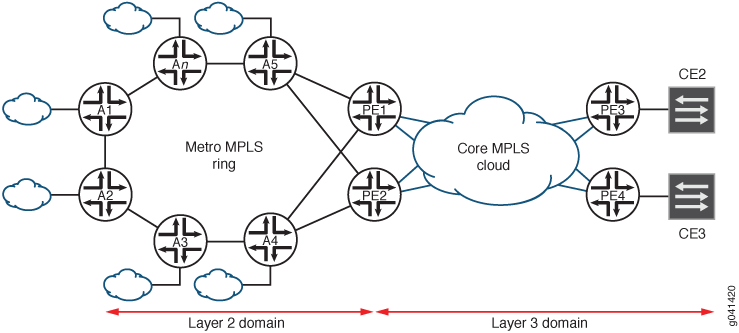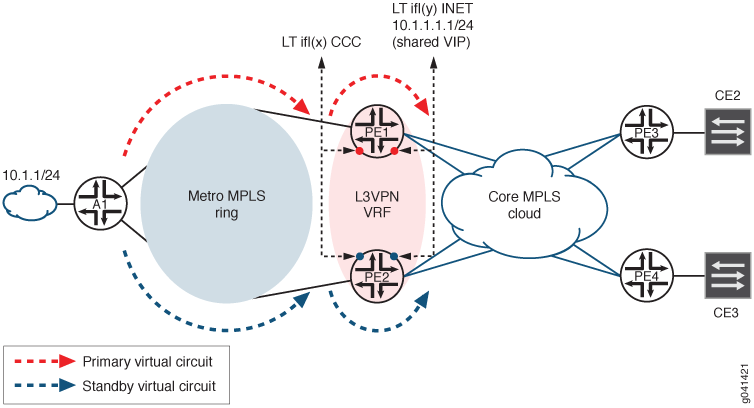Understanding Pseudowire Redundancy Mobile Backhaul Scenarios
With the rising demand for mobile broadband services, telecommunication providers are seeing a sharp increase in bandwidth requirements. To keep pace with demand, operators are deploying packet-based backhaul networks that offer increased capacity at a lower cost, while providing the necessary service reliability and quality of experience that users expect.
Most of the legacy backhaul infrastructure has been traditionally built over PDH microwave, TDM T1/E1, or ATM-over-DSL links. Service providers have traditionally added subsequent TDM links to their base stations when needed to deal with bandwidth constraint scenarios. This expansion model has proven to be inefficient for the unprecedented traffic demands required by 3G and Long Term Evolution (LTE) services. As a direct consequence, operators are gradually migrating to an Ethernet-based higher capacity infrastructure in the backhaul portion of 3G and LTE topologies. Modern base stations now provide Ethernet backhaul connectivity, allowing pseudowire technologies to transport end-user content to the desired destination. As part of this Ethernet transition, service providers are increasingly demanding better resiliency mechanisms to cover the existence gap with those features provided by previous legacy technologies. With that goal in mind, Junos OS provides efficient pseudowire redundancy capabilities to those topologies where Layer 2 and Layer 3 segments are interconnected.
Sample Topology
Figure 1 shows a sample topology.

Benefits of Pseudowire Redundancy Mobile Backhaul
Junos OS pseudowire redundancy capabilities are as follows:
-
Redundant loop-free paths to interconnect Layer 2 and Layer 3 domains.
-
Layer 2 and Layer 3 domains are synchronized with regard to the elected data path.
-
Traffic disruption is minimal for the following possible scenarios:
-
Access link failures
-
Node failures
-
Control-plane failures
-
-
Traffic interruption is minimal after the failure’s restoration is completed.
Layer 2 Virtual Circuit Status TLV Extension
The pseudowire status TLV is used to communicate the status of a pseudowire between provider edge (PE) routers. To avoid potential primary-path discrepancies, there must be a mechanism that allows all network elements to be synchronized with respect to the primary path over which traffic needs to be sent. With this goal in mind, the status TLV is extended to address this requirement.
The pseudowire status TLV is not supported by ACX5000 line of routers.
By having the active and standby states being defined by the access routers, Junos OS mitigates potential primary path collisions, as there is a unique network element dictating the preferable forwarding path to be elected. As an added value, this allows network operators to switch forwarding paths on demand, which is quite useful for troubleshooting and network maintenance purposes.
The active and standby states are communicated to the aggregation routers by making use of an additional pseudowire state flag.
Table 1 includes a list of the pseudowire state flags.
|
Flag |
Code |
|---|---|
|
L2CKT_PW_STATUS_PW_FWD |
0x00000000 |
|
L2CKT_PW_STATUS_PW_NOT_FWD |
0x00000001 |
|
L2CKT_PW_STATUS_AC_RX_FAULT |
0x00000002 |
|
L2CKT_PW_STATUS_AC_TX_FAULT |
0x00000004 |
|
L2CKT_PW_STATUS_PSN_RX_FAULT |
0x00000008 |
|
L2CKT_PW_STATUS_PSN_TX_FAULT |
0x00000010 |
|
L2CKT_PW_STATUS_PW_FWD_STDBY |
0x00000020 Indicates the standby state. |
|
L2CKT_PW_STATUS_SWITCH_OVER |
0x00000040 |
In multichassis LAG (MC-LAG)-based scenarios, this same PW_FWD_STDBY
flag is used to advertise to remote PE devices which attachment circuit
(AC) is being used as the active one. Upon arrival of this flag, the
receiving PE device drops any pseudowire built toward the router originating
this state. As we can see, this behavior denotes a slightly different
semantic for the PW_FWD_STDBY flag. As a consequence, you can configure
the hot-standby-vc-on statement to control whether the
pseudowire must be constructed upon arrival of the PW_FWD_STDBY flag
(in the hot-standby pseudowire scenario), or simply destroy it (in
the MC-LAG scenario).
How It Works
The solution uses logical tunnel (lt-) paired interfaces for stitching the Layer 2 and Layer 3 domains.
Figure 2 shows a diagram depicting how pseudowire redundancy in a mobile backhaul scenario works.

A Layer 2 pseudowire terminates on one of the logical tunnel interfaces (x), defined with the circuit cross-connect (CCC) address family configured. A Layer 3 VPN (RFC 2547) terminates the second logical tunnel interface (y), defined with the IPv4 (inet) address family. Logical tunnel interface (x) and (y) are paired. Layer 2 pseudowires established between each access router and its corresponding aggregation PE devices terminate on the logical tunnel interface defined within each PE device. This logical tunnel interface is used to establish a Layer 2 virtual circuit (VC) toward the remote end. In consequence, the CCC address family needs to be configured on it. The same applies to the remote end, where an equivalent interface needs to be defined with CCC capabilities.
This CCC logical tunnel interface created in the aggregation PE devices is paired with a second logical tunnel interface on which the INET address family is enabled. This second logical tunnel interface is configured within the context of an RFC 2547 Layer 3 VPN.
Within the scope of this document, we refer to the CCC and INET logical tunnel interfaces as LT(x) and LT(y), respectively.
The Junos OS routing protocol process (rpd) enables the stitching required to interconnect the Layer 2 VC ending in LT(x) and the associated LT(y).
In the aggregation PE routers, the routing process builds a pseudowire toward access routers, and this happens regardless of the active or standby state of the pseudowire. The same occurs in access routers, where the control and forwarding state is preestablished in both the Routing Engine and the Packet Forwarding Engine to mitigate traffic disruption during convergence periods.
An attachment circuit (AC) is a physical or virtual circuit (VC) that attaches a CE device to a PE device. Local preference is used to provide better information than the multiple exit discriminator (MED) value provides for a packet's path selection. You can configure the local preference attribute so that it has a higher value for prefixes received from a router that provides a desired path than prefixes received from a router that provides a less desirable path. The higher the value, the more preferred the route. The local preference attribute is the metric most often used in practice to express preferences for one set of paths over another.
If the Layer 2 circuit is primary, the corresponding PE device advertises the AC’s subnet with the higher local preference. All aggregation PE devices initially advertise the AC’s subnet with the same local preference. You can configure a routing policy to allow a higher local preference value to be advertised if the Layer 2 VC is active.
If a pseudowire is down, LT(x) is tagged with the CCC_Down flag. When this happens, the corresponding PE device withdraws the AC subnet that was initially advertised. The LT(y) address is shared between the aggregation PE devices as a virtual instance port (VIP). No VRRP hello messages are exchanged. Both PE devices assume the primary role.
Both primary and standby Layer 2 VCs are kept open to reduce
traffic disruption in backup-to-primary transitions. The hot-standby-vc-on
configuration statement allows manual
activation.
Resiliency in the Layer 2 domain is provided through plain pseudowire redundancy for back-to-back connections. For other topologies, pseudowire virtual circuit connectivity verification (VCCV) is used.
Resiliency in the Layer 3 domain is provided by MPLS fast reroute and end-to-end service restoration. A restoration timer prevents having VCs in the secondary path from being switched back to the primary path immediately after the primary PE device is restored.
Access routers can indicate to the aggregation routers which Layer 2 VC is considered to be active. Upon arrival at LT(x) of a status TLV message communicating a standby state, the routing process decreases the BGP's local preference value of the direct subnet represented by the LT(y) IPv4 address. At this point, BGP proceeds to advertise this local preference change to the rest of the members within the Layer 3 domain, which will then reelect the designated forwarder PE device by relying on BGP's path selection mechanisms.
A similar behavior occurs upon arrival of a status TLV message indicating a Layer 2 VC active state. In this case, the receiving PE device changes the local preference corresponding to the LT(y)'s subnet. The value to be used to either decrease or increase the subnet's local preference value is manually configured using a policy.
